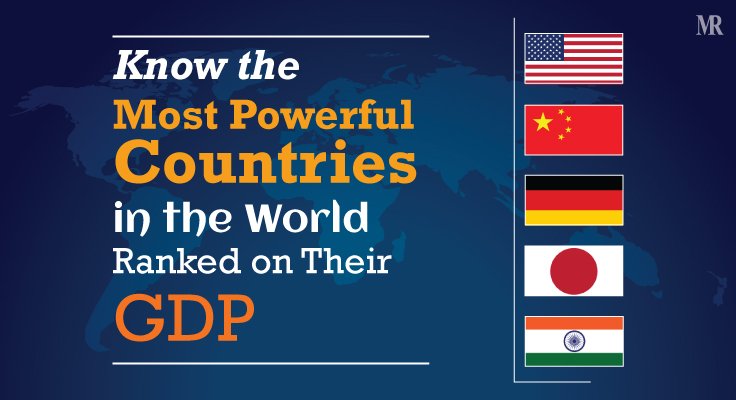The ever-shifting landscape of global influence sees a select few countries rise to become the most powerful countries in the world, wielding power that transcends borders.
This insightful exploration delves into the most powerful countries in the world, as measured by their Gross Domestic Product (GDP), to unveil the key factors shaping their dominance.
From iconic leaders and bustling capitals to vast territories and diverse populations, I have explored the crucial details that underpin each nation’s strength.
I have meticulously dissected the key sectors influencing their economic fortunes, focusing on the annual GDP growth rates of the top 5 contenders. This analysis paints a comprehensive picture of their economic prowess.
But power isn’t just about economic muscle. I have also focused on the formidable military strength of these 5 nations.
I have offered a deeper understanding of their strategic capabilities by analyzing their 2024 defense budgets and dissecting the factors contributing to their military might.
The blog’s exploration seamlessly transitions between economic and military facets, presenting a holistic view of the top 10 most powerful countries.
By considering more than just GDP, this blog provides a better understanding of their multifaceted dominance on the world stage.
Here Are The 5 Most Powerful Countries In The World
1. USA

- Leader: Joe Biden
- Population: 340 billion
- Area: 9.834 million km²
- Capital: Washington DC
- GDP: $27.36 trillion
The United States, a cornerstone of global influence, boasts an annual GDP growth rate of 1.5%.
But its power extends beyond mere numbers. Its economy, a veritable powerhouse, thrives on the diverse contributions of various sectors to its Gross Domestic Product:
The following are the key contributors to US GDP:
- Professional and business services: $3.5 trillion
- Real estate, rental, and leasing: $3.5 trillion
- Manufacturing: $2.9 trillion
- Educational services, health care, and social assistance: $2.3 trillion
- Finance and insurance: $2.0 trillion
- (List continues with remaining sectors and amounts)
- Beyond economic might, the US wields significant military strength, evident in its annual defense budget of $816.7 billion.
The US Govt. has allotted $842 billion as its defense budget for 2024. Notably, several key factors underpin this power:
Financial muscle: The US outspends all other nations on its military, allowing for investment in cutting-edge technology, weaponry, and training for its personnel.
Volunteer force: Unlike conscripted armies, the US relies on motivated and highly educated volunteers, fostering a strong sense of unity and dedication.
Air superiority: The US Air Force boasts an unparalleled fleet of advanced fighter jets and bombers, ensuring dominance in air combat and rapid global deployment.
Mighty Navy: With aircraft carriers at its core, the US Navy projects power across the world’s oceans. This “blue-water navy” safeguards vital sea lanes and provides crucial support for overseas operations.
Allied network: The US benefits from a network of global allies, bolstering its military reach and influence through shared intelligence and logistical support.
2. China

- Leader: Xi Jinping
- Population: 1.42 billion
- Area: 9.597 million km²
- Capital: Beijing
- GDP: $17.52 trillion
China ranks second in the list of the most powerful countries in the world based on its GDP. Boasting an impressive annual growth rate of 4.2%, its economic strength is undeniable.
These are the key sectors driving China’s growth:
- Industrial sector: 31.7%
- Wholesale and retail: 9.8%
- Finance: 8%
- Agriculture, fishery, and animal husbandry: 7.5%
- Construction: 6.8%
Beyond economic prowess, China’s military strength deserves attention. Its $224 billion defense budget fuels an impressive force, bolstered by several key factors:
Massive manpower: The People’s Liberation Army (PLA), with over 2 million personnel, constitutes the world’s largest active force. This sheer size translates into a formidable presence on the world stage.
Rapid Modernization: China prioritizes upgrading its military technology, and investing heavily in advanced jets, ballistic missiles, and other cutting-edge weaponry. This continuous innovation narrows the gap with established powers.
Focus on the Navy: With a growing fleet of aircraft carriers and submarines, the Navy receives particular attention, solidifying China’s maritime reach and influence.
Anti-access Area Denial: China strategically builds capabilities to restrict access to its territory, employing powerful missiles and other systems to deter potential adversaries.
Nuclear Deterrence: Though smaller compared to other nuclear arsenals, China’s stockpile adds a significant layer of complexity to any potential conflict, serving as a crucial deterrent.
3. Germany

- Leader: Olaf Scholz
- Population: 83 Million
- Area: 357,592 km²
- Capital: Berlin
- GDP: $4.509 trillion
Germany boasts the third spot on the list of most powerful countries in the world, driven largely by its economic might. With an annual GDP growth rate of 0.9%, the nation boasts a diversified economy.
The following are the sectors that have contributed to Germany’s economic boost:
- Agriculture, forestry, & fishing: 3.7%
- Manufacturing: 0.1%
- Construction: 0.2%
- Trade, transport, & services: -1.4%
- Information & communication: 1.1%
- Financial & insurance: -2.1%
- Real estate: 0.2%
- Business services: 0.0%
- Public services, education, health: 1.1%
- Other services: -0.8%
The German Govt. has invested $53.62 billion in its defense sector for this year. Notably, the following are the reasons why Germany’s Military is so strong:
Technological Prowess: Germany invests heavily in cutting-edge weaponry, like Leopard tanks and Eurofighters, ensuring a modern and effective arsenal.
Skilled Personnel: The Bundeswehr prioritizes high-quality training, fostering adaptable and skilled soldiers capable of handling diverse operations.
International Cooperation: Germany actively participates in NATO missions, gaining valuable experience and interoperability with allies, strengthening its international standing.
Defensive Posture: Post-war pacifism has shaped the Bundeswehr’s focus on peacekeeping and crisis response, contributing to a more stable international environment.
Economic Backing: Germany’s robust economy allows for sustained investment in military capabilities, ensuring continued readiness and effectiveness.
4. Japan

- Leader: Fumio Kishida
- Population: 122 Million
- Area: 377,973 km²
- Capital: Tokyo
- GDP: $4.21 trillion
Clocking in at number four on the list of most powerful countries, Japan leverages both economic might and strategic alliances to secure its global standing. Its robust GDP, boasting a 1.6% growth rate (2023-24), is underpinned by various sectors:
The following are the key sectors boosting Japan’s economy:
- Manufacturing: 18.7%
- Wholesale & Retail Trade: 13.9%
- Finance & Insurance: 10.4%
- Real Estate: 9.8%
- Public Administration: 7.5%
- Construction: 6.3%
- Military Might:
Despite pacifist constraints, Japan allocates a significant $56 billion (2024) to its defense, ensuring a potent force. This translates into several key strengths:
Technological Edge: Japan is a tech powerhouse, boasting world-class fighter jets, submarines, and destroyers. Its commitment to R&D ensures a constantly evolving arsenal.
Alliance Advantage: The close alliance with the US enables joint training, technology sharing, and operational planning, significantly amplifying capabilities.
Strategic Spending: Japan prioritizes quality over quantity, ensuring well-equipped and highly-trained forces. This strategic approach maximizes its military effectiveness.
Natural Defenses: Surrounded by water, Japan leverages geography to its advantage, focusing on maritime and air power, making it formidable at sea and in the sky.
Peaceful Posturing: Surprisingly, Japan’s pacifist stance contributes to its strength. By avoiding unnecessary conflicts, the nation can focus on efficient force modernization.
5. India

- Leader: Narendra Modi
- Population: 1.4 billion
- Area: 3.287 million km²
- Capital: Delhi
- GDP: $3.57 trillion
Rounding out the list of the 5 most powerful countries in the world based on the GDP, India stands tall with a booming economy and a formidable military. Its 7.3% annual GDP growth rate (2023-24) signifies a vibrant economy driven by diverse sectors.
The following are its key sectors boosting its economic engine:
- Agriculture, forestry, and fishing: 18.42%
- Mining and quarrying: 2.3%
- Manufacturing: 14.7%
- Finance, real estate, and other professional services: 21.42%
- Utility Services: 3%
- Construction: 8.19%
- Trade, hotel, transport, communication, and services related to broadcasting: 17.98%
- Administration and defense: 13.94%
Despite a modest defense budget of $7.49 billion (2024-25), India packs a punch with its military due to the following factors:
Sheer Manpower: With over 1.4 million active personnel, the world’s second-largest, India boasts a formidable ground presence.
Battle-Tested Resilience: Numerous conflicts have honed India’s troops, enabling them to adapt to diverse environments, and showcasing their resilience.
Self-Reliance: Prioritizing indigenous weapons development reduces dependence on external suppliers, strengthening self-reliance.
Nuclear Deterrence: As a declared nuclear state, India possesses a strategic atomic arsenal, deterring potential adversaries.
Modernization Drive: Recognizing the need for upgrades, India actively modernizes its armed forces, procuring advanced equipment to bolster its capabilities.
The Following Are The Top 10 Most Powerful Countries in the World Based On Their GDP
| Country | Leader | Capital | Population | Area | GDP | Military Size |
| USA | Joe Biden | Washington DC | 340 million | 9.834 million km² | $27.02 trillion | 2 million |
| China | Xi Jinping | Beijing | 1.42 billion | 9.597 million km² | $17.52 trillion | 761 million |
| Germany | Olaf Scholz | Berlin | 83 Million | 357,592 km² | $4.509 trillion | 181,672 thousand |
| Japan | Fumio Kishida | Tokyo | 122 Million | 377,973 km² | $4.21 trillion | 303,150 |
| India | Narendra Modi | Delhi | 1.4 billion | 3.287 million km² | $3.57 trillion | 1.5 million |
| UK | Rishi Sunak | London | 67 million | 243,610 km² | $3.203 trillion | 185,980 thousand |
| France | Emmanuel Macron | Paris | 64 million | 643,801 km² | $3.145 trillion | 198,241 thousand |
| Italy | Georgia Meloni | Rome | 59 million | 301,340 km2 | $2.629 trillion | 340,885 thousand |
| Brazil | Luiz Inácio Lula da Silva | Brasília | 220 million | 8.51 million km² | $2.126 trillion | 213,217 thousand |
| Canada | Justin Trudeau | Ottawa | 40 million | 9.985 million km² | $1.928 trillion | 98,500 thousand |
Conclusion
In conclusion, these are the most powerful countries in the world ranked on their GDP. I have highlighted important factors for each of the country. For the top 5 countries, I have put maximum focus on the key sectors that have contributed to their economy. Importantly, I have highlighted the reasons for their military strengths. I hope you enjoyed reading this blog. Keep reading Mirror Review.
Also Read: Highest Taxed Countries in the World [Updated 2024]












